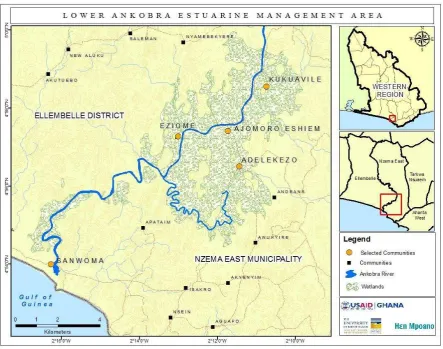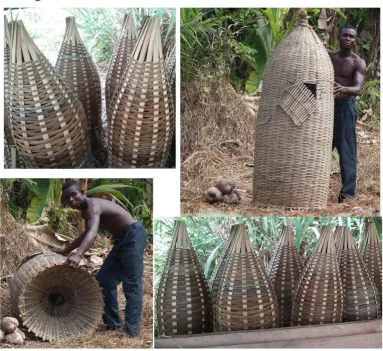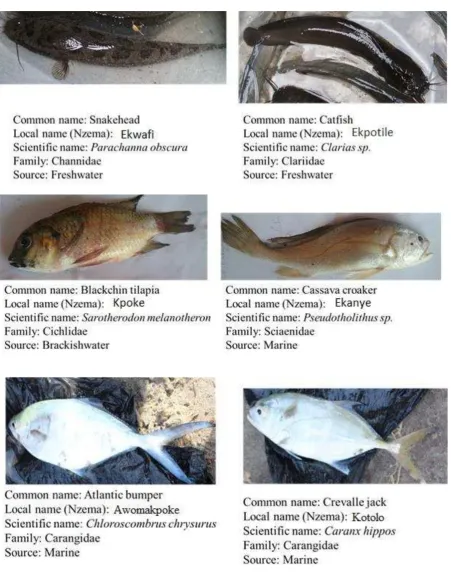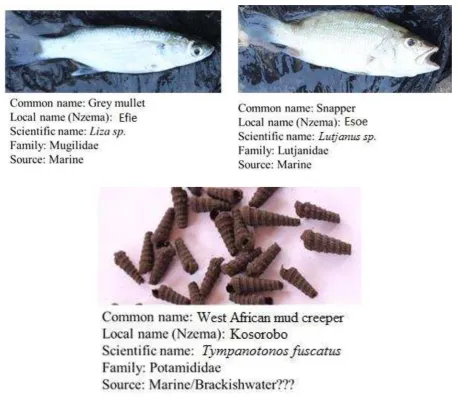SUSTAINABLE FISHERIES
MANAGEMENT PROJECT (SFMP)
Profile of Ankobra Estuary Resource
Users and Use Patterns
This publication is available electronically on the Coastal Resources Center’s website at http://www.crc.uri.edu/projects_page/ghanasfmp/
For more information on the Ghana Sustainable Fisheries Management Project, contact:
USAID/Ghana Sustainable Fisheries Management Project Coastal Resources Center
Graduate School of Oceanography University of Rhode Island
220 South Ferry Rd.
Narragansett, RI 02882 USA
Tel: 401-874-6224 Fax: 401-874-6920 Email: [email protected]
Citation: Hen Mpoano (2016). Profile of Ankobra Estuary Resource Users and Use Patterns.
The USAID/Ghana Sustainable Fisheries Management Project (SFMP). Narragansett, RI: Coastal Resources Center, Graduate School of Oceanography, University of Rhode Island and Hen Mpoano. GH2014_ACT081_HM 18 pp.
Authority/Disclaimer:
Prepared for USAID/Ghana under Cooperative Agreement (AID-641-A-15-00001) awarded on October 22, 2014 to the University of Rhode Island and entitled; the USAID/Ghana Sustainable Fisheries Management Project (SFMP).
This document is made possible by the support of the American People through the United States Agency for International Development (USAID). The views expressed and opinions contained in this report are those of the SFMP team and are not intended as statements of policy of either USAID or the cooperating organizations. As such, the contents of this report are the sole responsibility of the SFMP Project team and do not necessarily reflect the views of USAID or the United States Government.
Cover photo: Photo collage showing the Ankobra river, focus group discussion, fishing trap
Detailed Partner Contact Information:
USAID/Ghana Sustainable Fisheries Management Project (SFMP) 10 Obodai St., Mempeasem, East Legon, Accra, Ghana
Telephone: +233 0302 542497 Fax: +233 0302 542498
Maurice Knight Chief of Party [email protected]
Kofi Agbogah Senior Fisheries Advisor [email protected] Nii Odenkey Abbey Communications Officer [email protected]
Bakari Nyari Monitoring and Evaluation Specialist [email protected] Brian Crawford Project Manager, CRC [email protected]
Justice Odoi USAID Administrative Officer Representative [email protected] Kofi.Agbogah
SNV Netherlands Development Organisation #161, 10 Maseru Road,
E. Legon, Accra, Ghana 233 30 701 2440
Donkris Mevuta Kyei Yamoah [email protected] Friends of the Nation Parks and Gardens Adiembra-Sekondi, Ghana 233 312 046 180
Peter Owusu Donkor Spatial Solutions
[email protected] #3 Third Nautical Close,
Nungua, Accra, Ghana
Darkuman Junction, Kaneshie Odokor Highway
Accra, Ghana 233 302 315894
Gifty Asmah
[email protected] Daasgift Quality Foundation
Headmaster residence, Sekondi College Sekondi, Western Region, Ghana 233 243 326 178
For additional information on partner activities:
CRC/URI: http://www.crc.uri.edu CEWEFIA: http://cewefia.weebly.com/
DAA: http://womenthrive.org/development-action-association-daa Daasgift:
https://www.facebook.com/pages/Daasgift-Quality-Foundation-FNGO/135372649846101 Friends of the Nation: http://www.fonghana.org Hen Mpoano: http://www.henmpoano.org
ACRONYMS
CRC Coastal Resources Center
FGD Focus Group Discussions
SFMP Sustainable Fisheries Management Project
URI University of Rhode Island
TABLE OF CONTENTS
ACRONYMS ... iii
TABLE OF CONTENTS ... iv
LIST OF FIGURES ... iv
LIST OF TABLES ... iv
BACKGROUND ... 1
METHOD OF ASSESSMENT ... 1
RESOURCES, USERS AND USE PATTERNS... 3
The Ankobra’s natural resources and their utilization ... 3
Characteristics of resource users ... 4
The Ankobra estuary fishery ... 4
Scale, effort and seasonality ... 4
Fishing gear ... 5
Fisheries resources harvested from the estuary ... 5
Quantities harvested and cost... 7
MANAGEMENT PRACTICES ... 8
Perception of the effect of depletion of the estuary ... 9
Conflicts ... 9
CONCLUSIONS... 9
BIBLIOGRAPHY ... 10
APPENDIX 1 Sample questions used for the assessment ... 11
APPENDIX 2 A “bashing rubber” (side and top views) ... 13
LIST OF FIGURES
Figure 1: Map showing the communities assessed along the Ankobra estuary ... 2Figure 2: Sections of a focus group discussion at the communities visited... 3
Figure 3: Raffia pots used for fishing in the Ankobra Estuary ... 5
Figure 4: Some fishery resources harvested from the Ankobra Estuary ... 6
Figure 5: Additional fishery resources harvested from the Ankobra Estuary ... 7
LIST OF TABLES
Table 1: Ankobra estuary resources and uses ... 4BACKGROUND
Hen Mpoano, under the Sustainable Fisheries Management Project (SFMP) funded by the United States Agency for International Development (USAID) and led by the University of Rhode Island’s Coastal Resources Centre (URI-CRC) is working to build resilience of estuarine communities and ecosystems associated with the Ankobra River. The USAID-Ghana SFMP is a five-year effort aimed at rebuilding USAID-Ghana’s marine fish stocks and catches through the adoption of responsible fishing practices. The project contributes to the
Government of Ghana’s fisheries development objectives and USAID’s Feed the Future Initiative goals of improved food security, economic growth and poverty alleviation.
The Profile of Ankobra Estuary resource users and use patterns characterizes the users of the Ankobra estuary and their resource utilization patterns including their traditional management practices and perceptions. The process also investigated the fishery of the estuary to unearth key species and their subsistence and or commercial value. As a follow up activity to the Ankobra Climate and Livelihood Vulnerability assessment, this profile aims at developing further understanding about community and ecosystem resilience and laying the groundwork for the development of community-based estuarine fishery planning and management
approaches.
The Ankobra River Estuarine Basin located in the South-western part of Ghana flows about 190 km south to the Gulf of Guinea (Atlantic) just west of Axim through the tropical, evergreen wet forest. Its chief tributaries are the Mansi and the Bonsa rivers. The Ankobra River Basin is located between latitude 4° 50' N and 6° 30' N and longitude 1° 50' W and 2° 30' W. The basin is bounded to the east by the Pra Basin, to the north and west by the Tano Basin and in the south-east by the small coastal Butre Basin.
The resources of the Ankobra estuary contribute significantly to the livelihood of the river communities and provide critical ecosystem services to majority of the people living in the basin. However, human activities such as mining, logging, farming etc. are threatening the estuary and resulting in the depletion of fishery resources, forests, water and mangrove ecosystems associated with the estuary. The recent climate vulnerability assessment
completed by Hen Mpoano and Spatial solutions for the 5 estuarine communities also point to impacts of flooding and coastal erosion on critical livelihood assets.
METHOD OF ASSESSMENT
Figure 1: Map showing the communities assessed along the Ankobra estuary
The Focus Group Discussion (FGD) approach was adopted in soliciting information from the Ankobra resource users due to observed homogeneity in the pattern of utilization of the estuary’s resources among the communities. The FGD targeted community members
comprising young and old men and women who utilized resources of the Ankobra Estuary for livelihood related activities with much focus on the fishery, and other purposes.
Key issues covered were the variety of Ankobra estuary resources comprising flora and fauna and their uses including the specific utilization by fishers and farmers; the extent of
Figure 2: Sections of a focus group discussion at the communities visited
RESOURCES, USERS AND USE PATTERNS
The Ankobra’s natural resources and their utilizationTable 1: Ankobra estuary resources and uses
Resource Common use Specific use by fishers
Specific use by farmers
Ankobra River Transportation Fishing Herbicide
application
Fish Consumption Income
Mangrove Firewood for fish smoking, Building
Bamboo Fencing, Building
construction, firewood, roofing
Fencing
Rafia Making of brooms, brewing
of local gin, making of mats, for building
Making fishing traps
Sand Building fireplace
Crocodile For meat
Gold Income generation
Characteristics of resource users
The inhabitants of Eziom, Ajomoro Eshiem, Adelekezo and Kukuavile are predominantly farmers who fish as a second occupation. At Sanwoma, the men are mainly fishers while the women are fish mongers, with each engaging additionally in farming and mangrove
harvesting.
There are no existing associations or user groups that have organized themselves under one umbrella in relation to the resources of any kind. At Ajomoro Eshiem and Kukuavile, the only existing association is a Cocoa Farmers’ Association, which meets only when chemicals are supplied by government to be distributed. Once these chemicals are supplied the
association becomes inactive.
The people of Eziom, Eshiem, Kukuavile and Adelekezo ranked their income levels between low to medium while those at Sanwoma ranked their income between medium and high. The Ankobra estuary fishery
Scale, effort and seasonality
estuary; nevertheless, a considerable number of non-marine fishers still resort to the estuarine fishery.
Fishing gear
The main fishing gears used are gill nets and pots of various sizes constructed with raffia (see Figure 3). Cast nets, pole seine nets, hook and line, and bamboo traps are also considerably used for fishing
Figure 3: Raffia pots used for fishing in the Ankobra Estuary
Fisheries resources harvested from the estuary
Figure 5: Additional fishery resources harvested from the Ankobra Estuary
Quantities harvested and cost
MANAGEMENT PRACTICES
The five communities along the Ankobra River system have over the years managed the exploitation of the resources bestowed on them by the river. Until recently, these mangement practices have to a large extent contributed to the conservation of the Ankobra and its
resources.
The traditional authorities presiding over these communities are the custodian of culture and management practices that have protected the River from time long before. They are able to enact common informal laws that bind all the communities. Restriction on the cutting of mangrove along the river bank is one such management practices put in place by traditional authorities that binds on all the communities and their inhabitants harvesting resources from the Ankobra River. However, there are community specific rules and regulations that are in place to manage the resources harvested by community members.
Sanwoma
Mangroves along the river banks are not to be harvested. This is because community believes that the mangroves provide shelter for the fish and by cutting they would reduce the fish harvest in the community. Mangroves are also not harvested on Thursdays. Any one caught breaking the law is fined. The chief Fisherman and his elders enforce the law and community members self-police each other to ensure that the laws are adhered to.
Adelekezo
The community is supplied by the Ahama River a tributary of the Ankobra River. Use of chemicals to fish in the Ahama River is prohibited and no fishing on Saturday is allowed in the river. Harvesting of juvenile crabs and fish is also prohited by community law. Harvesting of the raffia can only be done with permission from community leaders.
To ensure the effectiveness of the law and adherence, fines such as bottles of schnapps and money are imposed on offenders. The communities self-police the resource also to ensure that all obey the laws.
Eshiem
In Eshiem, resources such as mangrove and raffia are managed by traditional authority and family elders. Cutting or harvesting of these resources can only be done with permission and payment of some monies to the elders of the community.
To harvest about a 100 bamboos, a sum of GHc20 cedis is paid and for the tapping of wine for the production of local gin, a tapper has to pay a one time ‘abusuatri Nsa’ (this is drink presented to the family on whose land the raffia pals resides) along with 5 gallons of the distilled local gin every month.
Compliance with these rules is ensured through community policing and self monitoring.
Eziom
Eziom, like the rest of the communities have their set of rules for harvesting of the resources. These include payment of 5 gallons of locally distilled gin to traditional authorities in the community every month. Every Friday of the third week, harvesting of bamboos and raffias are prohibited.
Kukuavile
The community, named after the founders of the community discovered abundance of cocoyam in the location whilst scouting for food, has rules and regulations that governs resource use.
The use of chemical in fishing and defaecation in the river is prohibited. Visitors seeking to harvest resource such as mangrove and raffia need to be permitted by the chief of the community before they can harvest.
Through community policing the rules are made effective. Offenders are fined through the traditional court system headed by the community chief.
Perception of the effect of depletion of the estuary
Inhabitants of the five communities along the Ankobra agree that continued degradation of the river would bring untold hardship and a possible death of the communities. This is because their survival depends on the health of the Ankobra River system.
To ensure that the river system remains sustainable community members agree that the following measures should be in place and practiced by all:
Riparian vegetation should be left intact to prevent the river from drying. Gold mining in the river must stop.
Small mesh size should not be used to fish in the river so that juvenile fishes are not harvested.
No chemical should be used or discharged into the river.
Farms should not be close to the river to prevent runoffs of agricultural chemicals into the river.
Replanting of mangrove as they are harvested.
Existing community laws should be followed as it is being done. Conflicts
The communities stated that there is no conflict between resource users in the harvesting of the resources. There is high level of compliance with the traditional laws governing the harvesting of the resources.
CONCLUSIONS
BIBLIOGRAPHY
King, M. (2007). Fisheries Biology, Assessment and Management. Blackwell Publishing Company. 382 pp.
Okyere, I. (2015). Assessment of aquatic ecosystems, the fishery and socio-economics of a coastal area in the Shama District, Ghana. Ph.D. Thesis, University of Cape Coast.
Paugy, D., Lévêque, C. & Teugels, G. G. (2003). The Fresh and Brackish Water Fishes of West Africa. Vol. II. IRD Editions, Publications Scientifiques du Muséum, MRAC, 815 pp.
Tobey, J., Robadue, D., Shaghude, Y.W., Muhando, C., Kalangahe, B., Mahenge, J., Daffa, J. (2013). State of Mbegani Bay: The Ecosystem, Livelihoods, and Future Status, Tanzania. Coastal Resources Center, Graduate School of Oceanography, University of Rhode Island, Narragansett, RI, 49 pp.
APPENDIX 1 SAMPLE QUESTIONS USED FOR THE ASSESSMENT
Assessment, Focus group and key informant checklist
Name of Community:
Resources and use patterns
Observe and identify (by local and scientific names) important flora and fauna associated with the Ankobra estuary and take note of dominant groups/species
List of Resources -
What are these resources used for?
Resource Use
How are they utilized by farmers and fishers?
Resource Use by farmers Use by fishers
How dependent are you on these resources for food and livelihood?
Rank these resources according to their importance to you? (The most important first and the least important last)
At what periods in the year are these resources harvested?
Describe the characteristics of the Ankobra estuarine fishery? To what extent is this commercial versus subsistence?- (Enumerator can additionally make his/her own observations on the characteristics of the fishery)
The scale (Subsistence vrs. Commercial) Number of Fishermen
Type of gear used Fishing periodicity Seasonality
Management Practices (Focus Group Discussion)
How is the Ankobra estuary and associated natural resources managed by surrounding communities?
Describe any specific roles played by women in managing these resources
What are the roles of traditional authorities and district assemblies?
What are the conflicts surrounding management of the estuary by different stakeholders? Identify active sources of conflicts and describe its main elements
Characteristics of resource users (Focus Group Discussion)
Are there any user groups organized under umbrella associations such as association of mangrove harvesters or timber loggers?
Provide names of some of the association of resource users if any?
Are they involved in any marketing networks? Please provide details.
How will you rank the income levels of the estuarine resource users – low, medium, high?
What are the major occupations of the resource users
Perceptions (Focus Group Discussion)
What will be the effect when the Ankobra estuary and associated natural resources are completed depleted?





